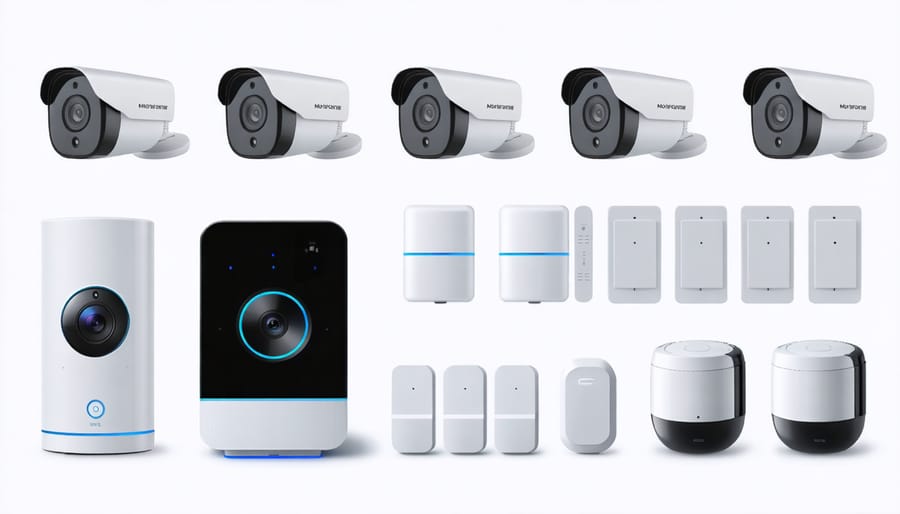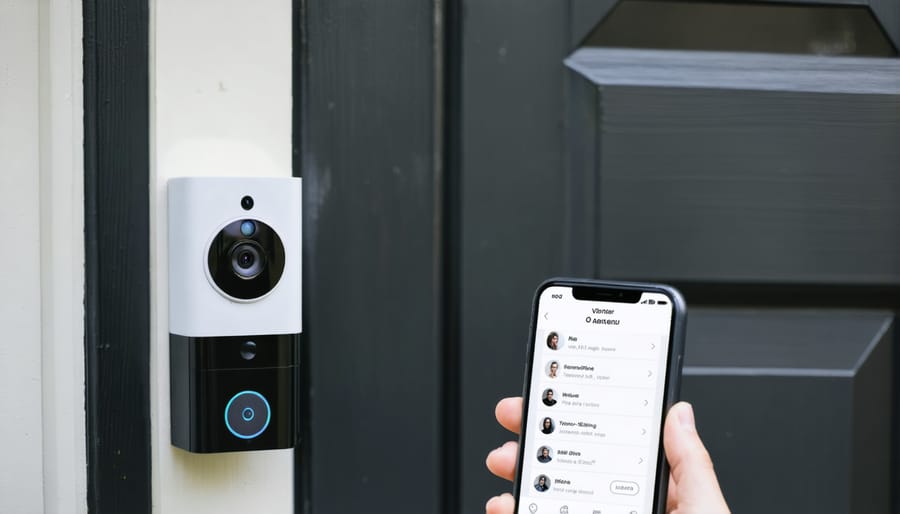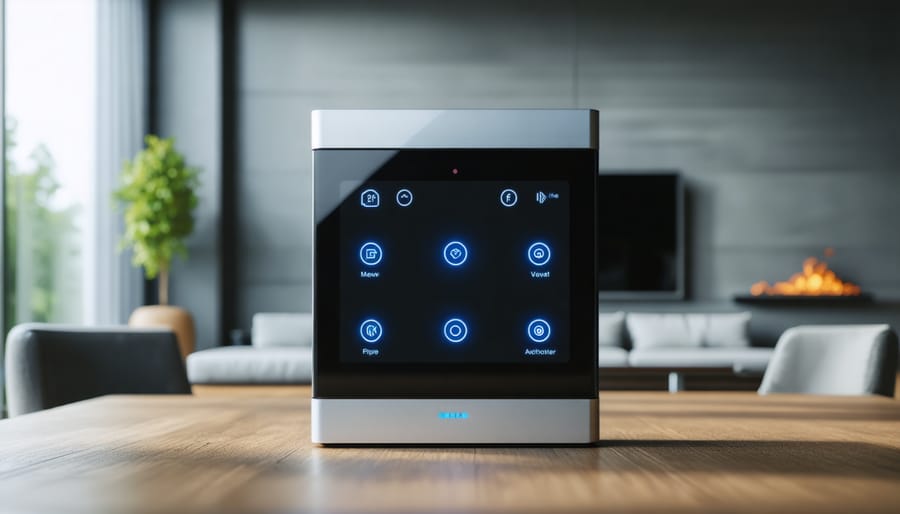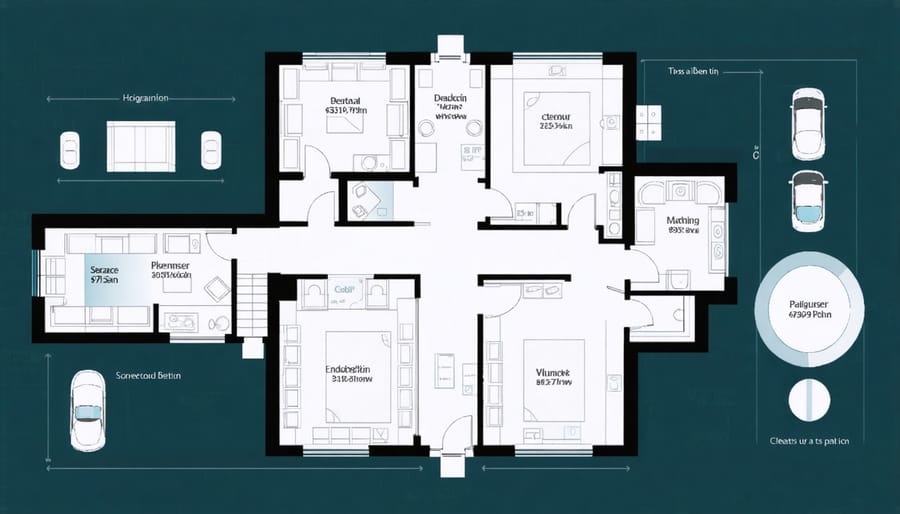Transform your home into an impenetrable fortress with today’s cutting-edge electronic security systems. Modern smart security solutions combine advanced surveillance cameras, intelligent sensors, and smartphone integration to protect what matters most – your family and belongings. Gone are the days of simple alarm systems; contemporary security setups offer real-time monitoring, instant mobile alerts, and seamless integration with your existing smart home devices.
Whether you’re looking to secure a small apartment or a sprawling estate, electronic security systems provide customizable protection that adapters to your specific needs. Motion detectors can distinguish between pets and intruders, while HD cameras with night vision capabilities ensure round-the-clock surveillance. The best part? You can monitor and control everything from your smartphone, whether you’re in bed upstairs or halfway around the world.
With features like automated door locks, doorbell cameras, and environmental sensors that detect smoke, carbon monoxide, and water leaks, these systems offer comprehensive protection against both security threats and environmental hazards. As home automation continues to evolve, electronic security systems stand at the forefront of innovative home protection, offering peace of mind through technology that’s both powerful and user-friendly.

Core Components of Modern Home Security Systems
Smart Cameras and Video Surveillance
Modern surveillance cameras have evolved far beyond simple recording devices, offering homeowners unprecedented control and peace of mind. Today’s smart cameras combine crystal-clear HD video with AI-powered security features that can distinguish between people, pets, and vehicles, dramatically reducing false alarms.
These intelligent devices offer real-time monitoring through user-friendly smartphone apps, letting you check on your home from anywhere in the world. When motion is detected, you’ll receive instant notifications with video clips, allowing you to quickly assess any situation and take appropriate action.
Many smart cameras now include two-way audio, enabling you to communicate with visitors or warn off potential intruders. Night vision capabilities ensure round-the-clock protection, while weather-resistant models stand up to the elements for reliable outdoor surveillance.
Storage options have also improved significantly. While local SD card storage remains available, most modern cameras offer cloud storage solutions that safely archive your footage and make it easily accessible when needed. Some systems even create time-lapse summaries of daily activities, helping you quickly review what’s happened at your property.
The latest models integrate seamlessly with other smart home devices. For example, your cameras can trigger smart lights when movement is detected or work with your smart doorbell to provide comprehensive entry monitoring. Many systems also offer customizable activity zones, letting you focus on specific areas while ignoring others to prevent unnecessary alerts.
For families concerned about privacy, look for cameras with physical privacy shutters and advanced encryption protocols that keep your footage secure from unauthorized access.
Door and Window Sensors
Door and window sensors are the vigilant guardians of your home’s entry points, alerting you whenever someone attempts to breach these vulnerable areas. These compact devices consist of two parts: a sensor and a magnet, which work together to detect when a door or window is opened. When properly installed, they form an invisible barrier that’s your first line of defense against intruders.
What makes these sensors particularly valuable in modern security systems is their seamless integration with smart home networks. Through your home’s wireless network, these sensors can send instant notifications to your smartphone, allowing you to monitor your property from anywhere. You can check if you remembered to close the garage door or receive alerts when the kids come home from school.
Many of today’s door and window sensors offer additional features beyond basic monitoring. Some can detect vibrations from attempted break-ins before entry occurs, while others include temperature sensors to alert you of potential fire hazards. Installation is typically straightforward – most sensors come with adhesive backing for tool-free mounting, though screw mounting options are available for more permanent installation.
For the best protection, place sensors on all ground-level entry points and any easily accessible upper-floor windows. Remember to test your sensors regularly and replace batteries as needed – most systems will alert you when battery levels are low.
Motion Detection Systems
Motion detection systems serve as vigilant guardians of your home, keeping watch even when you’re fast asleep or away. These clever devices use advanced sensors to detect movement and changes in your home’s environment, instantly alerting you to potential security threats.
Most modern motion sensors use passive infrared (PIR) technology, which detects changes in heat patterns caused by moving objects or people. When someone enters the monitored area, the sensor picks up their body heat and triggers an alert. Some advanced models even use dual-technology, combining PIR with microwave sensors for enhanced accuracy and fewer false alarms.
Strategic placement is key to maximizing your motion detectors’ effectiveness. Install them in high-traffic areas like entryways, hallways, and large rooms, particularly at points where intruders might enter. For best results, position sensors at corners where walls meet, about 6-8 feet from the floor, avoiding direct sunlight and heating vents.
Today’s smart motion sensors offer impressive features beyond basic detection. Many integrate seamlessly with your smartphone, sending instant notifications when movement is detected. Some can even distinguish between pets and people, reducing false alarms that might otherwise disturb your peace of mind.
Expert tip: Consider motion sensors with adjustable sensitivity settings. This allows you to fine-tune the system based on your specific needs and home environment, ensuring reliable protection without unnecessary alerts.
Smart Integration Features
Mobile App Control and Alerts
Modern security systems have revolutionized how we interact with our home’s safety features through convenient mobile apps. These user-friendly applications put complete control of your security system right at your fingertips, whether you’re at work, on vacation, or just relaxing in bed.
With today’s mobile apps, you can arm or disarm your system, view live camera feeds, and receive instant notifications about any suspicious activity. Many systems offer self-monitored security options, giving you the freedom to manage your home’s security without monthly monitoring fees.
The apps typically feature customizable alerts for different scenarios – from motion detection to door openings – and let you create unique access codes for family members or trusted visitors. You’ll receive real-time push notifications when someone enters your home, when a sensor is triggered, or if there’s unusual activity detected by your cameras.
Most security apps also include advanced emergency response capabilities, allowing you to quickly contact authorities with just a tap. Some apps even maintain an event history, letting you review past incidents and check when specific doors were opened or when the system was armed or disarmed.
For added convenience, these apps often integrate with other smart home devices, allowing you to control lighting, thermostats, and door locks alongside your security features – all from the same interface.

Voice Assistant Compatibility
Modern electronic security systems have embraced the convenience of voice control, making it easier than ever to manage your home’s security through simple verbal commands. Popular voice assistants like Amazon Alexa, Google Assistant, and Apple’s Siri can now seamlessly integrate with many security systems, allowing you to arm, disarm, and check system status hands-free.
To get started with voice control, ensure your security system is compatible with your preferred voice assistant. Most major security brands now offer this integration out of the box. Once connected, you can use commands like “Alexa, arm the security system” or “Hey Google, is my front door locked?” The setup process typically involves linking your security system account through the voice assistant’s app.
Voice control adds an extra layer of convenience, especially when your hands are full or you’re rushing out the door. You can check camera feeds, control smart locks, and even receive security alerts through your voice assistant. For added security, many systems allow you to set up voice PINs or codes that must be spoken to perform sensitive actions like disarming the system.
Remember that while voice control is incredibly convenient, it’s important to use strong, unique voice passwords and regularly update your system’s firmware to maintain security. Some systems also offer multi-factor authentication for additional protection when using voice commands.

Installation and Setup Considerations
Professional vs. DIY Installation
When it comes to installing electronic security systems, you’ll need to choose between professional installation and the increasingly popular DIY security system installation approach. Each option has its own set of advantages and considerations worth exploring.
Professional installation offers peace of mind through expert setup and configuration. Trained technicians ensure all components are properly placed and integrated, reducing the risk of system vulnerabilities. They can also provide valuable advice on optimal sensor placement and system customization. However, professional installation typically comes with higher upfront costs and may require scheduling appointments around the installer’s availability.
The DIY route has gained popularity thanks to user-friendly systems and comprehensive installation guides. Modern security systems often come with step-by-step mobile apps, making setup more accessible than ever. DIY installation offers significant cost savings and the flexibility to install at your convenience. You’ll also gain a better understanding of your system’s features and operation through the installation process.
Consider your technical comfort level, available time, and system complexity when making your choice. While simpler systems with wireless components are generally suitable for DIY installation, more complex setups involving hardwiring or advanced integration might benefit from professional expertise. Remember that many manufacturers offer hybrid options, allowing you to start with DIY installation while maintaining access to professional support if needed.
Optimal Component Placement
Strategic placement of security components is crucial for maximizing your system’s effectiveness. Start by positioning your control panel in a central, easily accessible location that’s out of sight from windows. This ensures quick access while preventing potential intruders from spotting it.
Install motion sensors in high-traffic areas and corners where they can cover the maximum space. Aim to create overlapping detection zones, particularly in main living areas and near entry points. Mount them at about 6-8 feet high, angling slightly downward for optimal coverage.
Security cameras should be placed at all entry points, including doors and first-floor windows. Position outdoor cameras under eaves or protective covers to shield them from weather while maintaining clear sight lines. For indoor cameras, focus on main living spaces and entry hallways, but avoid bathrooms and bedrooms for privacy.
Door and window sensors need precise alignment to work effectively. Install them on the frame side that opens, ensuring the magnetic components line up perfectly when closed. Remember to test each component after installation to confirm proper functionality and coverage.

Future-Proofing Your Security System
When it comes to future-proofing your electronic security system, flexibility and scalability are your best friends. Today’s security solutions should grow with your needs and adapt to emerging technologies. Look for systems with modular designs that allow you to add components over time without replacing the entire setup.
The future of home security is rapidly evolving, with biometric security technology leading the way. Consider investing in systems that can integrate with these advanced features when you’re ready to upgrade. Cloud connectivity is another crucial feature to look for, as it enables remote monitoring and regular software updates that keep your system current.
Think about compatibility with emerging smart home standards like Matter and Thread. These protocols are designed to ensure different devices work together seamlessly, regardless of their brand. When choosing your system, check if it’s “Matter-ready” or has a clear upgrade path to support these standards.
Don’t forget about artificial intelligence capabilities. Modern systems increasingly use AI for more accurate threat detection and fewer false alarms. Even if you’re not ready for AI features now, choosing a system that can support them through software updates will keep your security current for years to come.
Remember, the goal isn’t to buy every new feature available but to create a foundation that can evolve with both your needs and technological advances.
Electronic security systems have evolved from simple alarm setups to comprehensive smart home solutions that protect and enhance our daily lives. Throughout this guide, we’ve explored the essential components that make up a modern security system, from cameras and sensors to smart locks and integrated mobile apps. The key takeaway is that today’s security solutions offer unprecedented flexibility and control, allowing you to customize your system based on your specific needs and preferences.
Remember that the best security system is one that fits your lifestyle while providing reliable protection. Whether you choose a professionally installed system or opt for a DIY approach, ensure your setup includes fundamental elements like motion sensors, door/window contacts, and cameras. Smart integration capabilities are worth considering, as they can significantly improve your system’s functionality and convenience.
For the best results, start with a thorough assessment of your security needs, create a comprehensive plan, and consider future expansion possibilities. Don’t forget to regularly maintain and update your system, test all components monthly, and keep backup power sources ready. While the initial investment might seem substantial, the peace of mind and protection an electronic security system provides are invaluable.
Finally, stay informed about emerging technologies and security trends, but focus on implementing reliable, proven solutions rather than chasing the latest gadgets. Your security system should be both effective and user-friendly, serving as a guardian that enhances your home life rather than complicating it.
